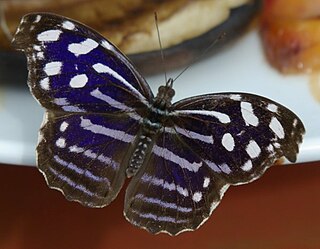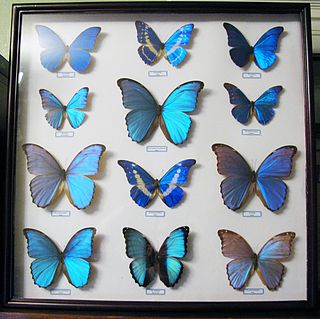
Danainae is a subfamily of the family Nymphalidae, the brush-footed butterflies. It includes the Daniadae, or milkweed butterflies, who lay their eggs on various milkweeds on which their larvae (caterpillars) feed, as well as the clearwing butterflies (Ithomiini), and the tellervini.

The Nymphalidae are the largest family of butterflies, with more than 6,000 species distributed throughout most of the world. Belonging to the superfamily Papilionoidea, they are usually medium-sized to large butterflies. Most species have a reduced pair of forelegs and many hold their colourful wings flat when resting. They are also called brush-footed butterflies or four-footed butterflies, because they are known to stand on only four legs while the other two are curled up; in some species, these forelegs have a brush-like set of hairs, which gives this family its other common name. Many species are brightly coloured and include popular species such as the emperors, monarch butterfly, admirals, tortoiseshells, and fritillaries. However, the under wings are, in contrast, often dull and in some species look remarkably like dead leaves, or are much paler, producing a cryptic effect that helps the butterflies blend into their surroundings.

The morpho butterflies comprise many species of Neotropical butterfly under the genus Morpho. This genus includes more than 29 accepted species and 147 accepted subspecies, found mostly in South America, Mexico, and Central America. Morpho wingspans range from 7.5 cm (3.0 in) for M. rhodopteron to 20 cm (7.9 in) for M. hecuba, the imposing sunset morpho. The name morpho, meaning "changed" or "modified", is also an epithet. Blue morphos are severely threatened by the deforestation of tropical forests and habitat fragmentation. Humans provide a direct threat to this genus because their beauty attracts artists and collectors from all over the globe who wish to capture and display them. Aside from humans, birds like the jacamar and flycatcher are the adult butterfly’s natural predators.

A proboscis is an elongated appendage from the head of an animal, either a vertebrate or an invertebrate. In invertebrates, the term usually refers to tubular mouthparts used for feeding and sucking. In vertebrates, a proboscis is an elongated nose or snout.

The superfamily Papilionoidea contains all the butterflies except for the moth-like Hedyloidea.

The Heliconiinae, commonly called heliconians or longwings, are a subfamily of the brush-footed butterflies. They can be divided into 45–50 genera and were sometimes treated as a separate family Heliconiidae within the Papilionoidea. The colouration is predominantly reddish and black, and though of varying wing shape, the forewings are always elongated tipwards, hence the common name.

The Satyrinae, the satyrines or satyrids, commonly known as the browns, are a subfamily of the Nymphalidae. They were formerly considered a distinct family, Satyridae. This group contains nearly half of the known diversity of brush-footed butterflies. The true number of the Satyrinae species is estimated to exceed 2,400.

Danaus genutia, the common tiger, is one of the common butterflies of India. It belongs to the "crows and tigers", that is, the Danainae group of the brush-footed butterflies family. The butterfly is also called striped tiger in India to differentiate it from the equally common plain tiger, Danaus chrysippus. The species was first described by Pieter Cramer in 1779.

Hypolimnas bolina, the great eggfly, common eggfly, varied eggfly, or in New Zealand the blue moon butterfly, is a species of nymphalid butterfly found from Madagascar to Asia and Australia.

Euploea algea, the long branded blue crow, is a butterfly found in India and Southeast Asia that belongs to the crows and tigers, that is, the Danaid group of the brush-footed butterflies family.

Archaeoprepona demophon, the one-spotted prepona, banded king shoemaker, or demophon shoemaker is a butterfly belonging to the family Nymphalidae.

Biblidinae is a subfamily of nymphalid butterflies that includes the tropical brushfoots. This subfamily was sometimes merged within the Limenitidinae, but they are now recognized as quite distinct lineages. In older literature, this subfamily is sometimes called Eurytelinae.

The Morphinae are a subfamily of Nymphalidae butterflies that includes the morphos, the owl butterflies (Caligo), and related lineages. It is either considered a sister group of the Satyrinae, or disassembled and included therein.
Butterfly evolution is the origin and diversification of butterflies through geologic time and over a large portion of the Earth's surface. The earliest known butterfly fossils are from the mid Eocene epoch, between 40-50 million years ago. Their development is closely linked to the evolution of flowering plants, since both adult butterflies and caterpillars feed on flowering plants. Of the 220,000 species of Lepidoptera, about 45,000 species are butterflies, which probably evolved from moths. Butterflies are found throughout the world, except in Antarctica, and are especially numerous in the tropics; they fall into eight different families.

The Elymniini is one of the tribes of the subfamily Satyrinae. If the subfamily Satyrinae elevate to family status, this tribe shall be treated as subfamily Elymniinae. Elymniini was formerly a large group, but recently, it is considered to be include only one genus, Elymnias, according to molecular phylogenetic analyses.

Junonia evarete, the tropical buckeye or South American tropical buckeye, is a South American butterfly of the nymphalid (Nymphalidae) family. It has characteristic eye spots on the wings, which have a wingspan between 4.5 and 6.5 cm. This butterfly is easily confused with Junonia genoveva, the mangrove buckeye. Not only have the common names mangrove and tropical buckeye been confused, but the butterflies themselves have been sometimes misidentified in past literature because the two species have many variations, subspecies and seasonal forms, which makes them difficult to identify or differentiate. Phylogenetic studies demonstrate the separation of evarete and genoveva, but evidence suggests that subspecies and perhaps more species await their descriptions within this group.

The Libytheinae are a nymphalid subfamily known as snout butterflies, containing two valid genera and about ten species: six in Libythea and four in Libytheana. The common name refers to the thick labial palps (pedipalps) that look like a "snout" in this subfamily. In older literature, this group was recognized as the family Libytheidae. They are medium-sized and typically a drab brown. The front legs are reduced in length and the ventral hindwings are cryptically colored to help them blend in with their surroundings. While at rest, the members of this subfamily keep their wings tightly closed to resemble dead leaves.















